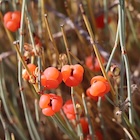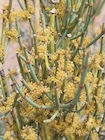Conservation Status

Ephedra intermedia
Schrenk & C.A. Meyer ex C.A. Meyer 1846
Common names
中麻黄 zhong ma huang [Chinese] (Fu et al. 1999).
Taxonomic notes
Type: Kazakhstan, Tarbagatay, Songoria, 12 Aug 1840, A. G. von Schrenk s.n. Herb. Al. de Bunge (possible syntype P, barcode P007388825). Synonymy: Many names, see POWO for a full list, except that I add E. glauca Regel to the list, in accordance with Fu et al. (1999). The hybrid with E. strobilacea is Ephedra × eleutherolepis V.A. Nikitin 1966, and has only been reported from Tadzhikistan.
Description
Dioecious or monoecious erect to procumbent shrubs up to 2 m tall, densely branched, erect to spreading or sometimes with a creeping stem producing single, erect, green primary branches. Bark brownish black, longitudinally fissured and sheathed. Twigs straight or slightly bent, 1.5-3.5 mm diameter, yellowish or bluish green, longitudinally ridged with minute cuticular papillae on the ridges and stomata in the intervening furrows, internodes usually 2-6 cm long. Leaves 2–3 per node, connate for 60-80% of their length, ephemeral, apices free, tapering proximally, acute to acuminate. Cones axillary (rarely terminal) in whorls of 2–18 per node, sessile or on a 3-9 mm peduncle, paired or trimerous, bracts opposite and decussate; bisexual strobili occur occasionally. Pollen cones orange to yellow, sessile or shortly stipitate, 6–12 × 6–8 mm, with 2–3 proximal whorled sterile bracts and 4–8 fertile bracts. Seed cones ellipsoid, ovoid, or oblong-ovoid, 6–9 × 3–5 mm, bracts in 2-6 pairs or whorls, outer ones connate at base, apical pair or whorl connate for ca. 1/2 their length, margins membranous, globose; micropylar tube brown, straight to coiled/twisted, 2.5–5 × 0.10–0.15 mm, pore diameter 0.12–0.16 mm with one side open. Mature seed cone fleshy and red, orange or yellow, 8–12 × 6–10 mm, sessile or on a peduncle to 9 mm long, basal sterile bracts light golden to brown and apical bracts colored with hyaline margins, distalmost bract whorl connate up to 70–90% length bearing 2 (rarely 1 or 3) seeds per strobilus. Seeds 2 or 3, ovoid or elongate-ovoid, ventrally flat and dorsally convex with faintly irregular ridges, 4-6 × 2.5–3.5 mm, brown to black, sometimes mottled with rectangular yellow patches, concealed by bracts. Pollination May-Jun, seed maturity Jul-Aug. 2n = 14, 28 (Ali and Qaiser 1987, Fu et al. 1999, Rather and Khuroo 2022).
Distribution and Ecology
Afghanistan; India: Himachal Pradesh, Jammu & Kashmir, Ladakh, Uttarakhand; Kazakstan; Kyrgyzstan; Mongolia; Pakistan; Russia; Tajikistan; Turkmenistan; Uzbekistan; SW Asia; China: Gansu, Hebei, Liaoning, Nei Mongol, Ningxia, Qinghai, Shaanxi, Shandong, Shanxi, Xinjiang, and Xizang. Found at (100-)800-5000 m elevation in grasslands, deserts, river valleys, floodplains, sandy beaches, cliffs, and other dry, sandy or rocky places (Fu et al. 1999, Rather and Khuroo 2022).
Remarkable Specimens
No data as of 2023.03.03.
Ethnobotany
"This species has medicinal properties" (Fu et al. 1999).
Observations
See the observations on iNaturalist, accessed 2021.12.30.
Remarks
The epithet refers to the plant's appearance as intermediate between "E. helveticam et E. monospermum" (now known as E. distachya subsp. helvetica and E. monosperma) (Meyer 1846).
Citations
Ali, S.I. and M. Qaiser (eds.). 1987. Flora of Pakistan. http://www.efloras.org.
Bobrov, E. G. 1968. Ephedraceae, pp. 154-160 in V.L. Komarov (ed.), Flora of the USSR, Vol. 1, trans. by the Israel Program for Scientific Translations. Washington DC: Smithsonian Institution and National Science Foundation. Available: Biodiversity Heritage Library, accessed 2021.12.29.
Meyer, C. A. 1846. Versuch einer Monographie der Gattung Ephedra, Durch Abbildungen Erlautert. Mémoires de l'Académie impériale des sciences de St.-Pétersbourg, Sér. 6, Sci. Math., Seconde Pt. Sci. Nat. 5:88. Available: Biodiversity Heritage Library, accessed 2021.12.31.
Nikitin, V.A. 1966. Novosti Sist. Vyssh. Rast. 1966:5.
Rather, Zubair Admad, and Anzar Ahmad Khuroo. 2022. Ephedra pangiensis, a new synonym of E. intermedia (Ephedraceae). Phytotaxa 533(1):83-90. doi.org/10.11646/phytotaxa.533.1.5. Profusely illustrated.
See also
Species profile at Plants of the World Online, accessed 2021.12.30.




